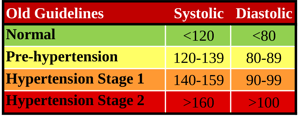 Recently, two national health organizations, the American Heart Association (AHA) and the American College of Cardiology (ACC), updated hypertension guidelines. The previous guidelines for high blood pressure diagnosis were 140 mm Hg/90 mmHg while the new guidelines for high blood pressure are 130 mm Hg/80 mmHg. What does this mean for your employees? Does it impact your workplace wellbeing efforts?
Recently, two national health organizations, the American Heart Association (AHA) and the American College of Cardiology (ACC), updated hypertension guidelines. The previous guidelines for high blood pressure diagnosis were 140 mm Hg/90 mmHg while the new guidelines for high blood pressure are 130 mm Hg/80 mmHg. What does this mean for your employees? Does it impact your workplace wellbeing efforts?
What Is High Blood Pressure?
 As your heart beats, it creates pressure that delivers blood to the body through a network of blood vessels. Blood pressure measures the force of blood as it flows against the blood vessel walls and is the result of two forces.
As your heart beats, it creates pressure that delivers blood to the body through a network of blood vessels. Blood pressure measures the force of blood as it flows against the blood vessel walls and is the result of two forces.

The first force is the systolic pressure and occurs as blood pumps out of the heart and into the blood vessels. This is the number represented as the top number in your blood pressure reading. The second force is the diastolic pressure and is created as the heart rests between heart beats. This is represented as the bottom number in your blood pressure reading.
High blood pressure, or hypertension, is when your blood pressure is consistently too high, which would be any reading above 130/80 under the new recommendations.
High blood pressure is known as the silent killer, as the damage it causes over time often has no obvious symptoms. As pressure increases, the heart and blood vessels gradually need to work harder and eventually the tissue will be damaged. Left untreated, high blood pressure can lead to cardiovascular diseases and it is the leading cause of death from heart attacks and stroke.
Why The Change?
The blood pressure guidelines were updated based on thorough review of the latest clinical research data and have shown that complications have occurred at readings in the 120 – 139/80-89 ranges. The changes have been put in place to help physicians deliver a higher quality of care by implementing earlier interventions that can be used to treat and prevent cardiovascular health risks.
What’s The Risk?
With the updated guidelines, nearly half of Americans meet the diagnosis criteria for high blood pressure. Those who are already being treated for high blood pressure will need to talk with their primary care physicians about whether their blood pressure goals need to be adjusted.
Employers with an outcomes-based wellness program, or companies that reward employees for reaching certain health goals, should evaluate their wellness program designs and update their blood pressure goals to align with the new guidelines. Due to the timing of the release of the new guidelines, most employers will want to discuss the new guidelines as they plan for 2019 incentives. However, this update should be kept in consideration for this year and communicated to employees with education surrounding high blood pressure, including risk factors and early intervention treatments, such as lifestyle changes in diet and activity.
All employers should be familiar with the new guidelines, not just how they affect their plans, but also with the impact that it will have on the health of their employees.
For more information or questions on wellness program design contact the Gibson Health Risk Management Team.
To read the full text of the new guidelines, click here for the report from the AHA and ACC.




